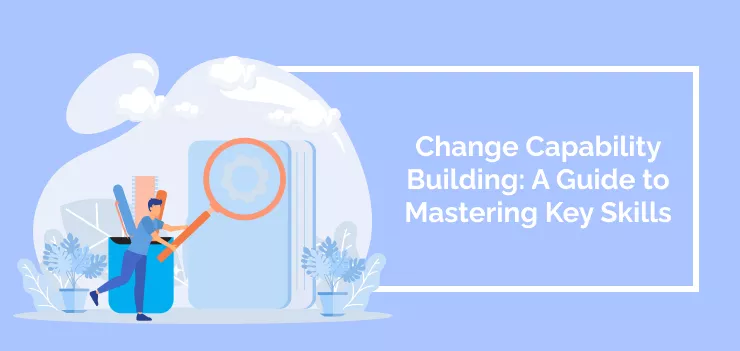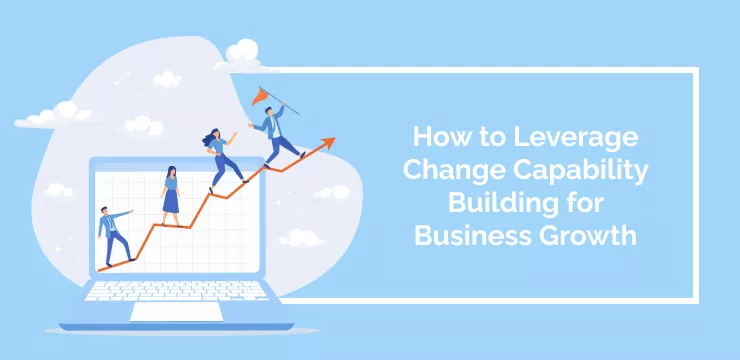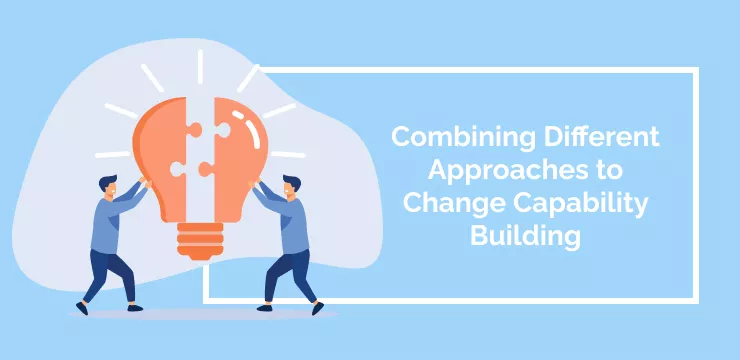
Innovation within the business arena brings about a constant sea of change, and organizations must be capable of adapting quickly or risk being outpaced by the competition. Change capabilities are a methodology for measuring an array of organizational aspects that influence an organization’s ability to affect change, along with capabilities that help identify, deliver and sustain it.
OCM is an overarching term that describes a set of practices and principles helping to support and guide teams throughout the delivery of company-wide transformations.
Building change capabilities typically requires agile organizational change management (OCM) on behalf of leaders. To foster adaptability and minimize resistance to change, the change process encompasses training personnel with new tools, techniques, or technologies; creating innovative strategies; and promoting an organizational culture equipped for maneuvering market changes.
If change initiatives are to be successful, it also means setting up suitable mechanisms for assessing change capabilities and leveraging that data to affect change in a way that keeps potential negative impacts on people and processes to a minimum.
To facilitate an environment conducive for growth, change management capability initiatives allows organizations to identify areas for improvement, develop plans to improve processes and systems, and assess how changes will impact the organization.
Change management adoption is a key element of change capability building. Organizations must understand the importance of using and adhering to processes when introducing new initiatives and ensure everyone involved is on board with the changes. This includes effective communication, understanding stakeholder needs, and developing policies and procedures to support the new initiatives.
Successful organizational change capability requires collective commitment, dedication, and follow-through. Organizations must be willing to invest in the change process, invest in employees to ensure they are knowledgeable about changes, and create a culture of continuous improvement to sustain the changes.
What is Change Capability Building?
Change capability building enables companies to craft the tools, expertise, and competencies required to thrive in an increasingly altering climate.
According to Garner, Only one-third of change initiatives succeed. At the same time, leaders expect more changes to occur.
Developing the ability to quickly and effectively respond to market shifts necessitates training individuals in fresh strategies, technologies, or systems, generating innovative tactics, and forming corporate adaptability.
Building an organization’s capability to adapt to change is integral in cultivating a culture of innovation that paves the way for progress and staying ahead of its rivals. Change management consultants are instrumental in providing organizations with the support they need by pinpointing areas of improvement, designing plans to help improve processes and systems and assessing how alterations could affect the company.
How to Leverage Change Capability Building for Business Growth

Organizational transformation led by change capability building is a complex concept requiring multiple stakeholders’ involvement.
To ensure the successful implementation of such changes, it is imperative to understand the importance of following processes while implementing new initiatives. This includes communicating effectively, comprehending stakeholder needs, and creating policies or procedures to help back up these alterations.
Successful change capability building necessitates organizational commitment, assiduity, and follow-through. Companies must be willing to invest in the change process, fund employees’ training to guarantee they are well-versed with such changes and create a culture of continuous improvement to sustain them.
Identifying Organizational Gaps in Change Capability Building
To get the most out of change capability building, organizations need to assess where they currently stand and where they want to be regarding their ability to manage change. Assessing your organization’s current change capability is essential in this process.
You can start by evaluating your organizational change management capability.
Look at:
- How willing your team is to accept change
- How well you communicate with each other
- How quickly you can adapt to different scenarios
You should also measure the effectiveness of your change initiatives by gathering data on their implementation. This will help you identify areas where improvement is needed, such as communication or culture.
Look at the systems and processes and identify potential improvement areas, emphasizing building change management capabilities. This could include streamlining processes, creating better systems for tracking progress, or improving the overall customer experience.
Developing a Comprehensive Change Capability Building Framework
Once you have identified areas for improvement, the next step is to develop a comprehensive framework or (change management methodology) for change capability building. This should include training employees, developing effective communication strategies, and implementing systems that enable better collaboration and decision-making.
It’s also important to consider how you can provide incentives or rewards to your team members who are leading the change process or demonstrating high levels of commitment. You should also make sure that any changes made are objectively measured so you can track progress over time.
It’s essential to continually monitor and measure performance to ensure that the organization remains on track with its initiatives and goals. Regularly revisiting existing frameworks will help organizations identify further opportunities for improvement and stay ahead of the game.
The Benefits of Investing in Building Change Capability
The benefits of investing in change capability programs are plentiful. Companies that embrace change and invest in their employees’ training will be better equipped to manage unexpected scenarios and make informed decisions based on data.
According to a recent report on Building Sustainable Change Capability from David Miller, Managing Director, Change First, Haywards Heath, UK, “Leaders must be able to transform their organizations regularly to deliver long‐term competitive advantage, in an environment where organizational change is becoming more frequent, complex and risky.”
This shows how vital it is to have change capability programs in place. Companies that invest in such training initiatives are better equipped to manage sudden market shifts, economic downturns, and technological advances.
We’ve identified the following benefits:
- Improved decision-making: Employees will be more informed with better understanding of change management processes, allowing them to make data-driven decisions.
- Enhanced communication: Change capability building helps teams stay connected and understand each other better, leading to improved collaboration and productivity.
- Increased teamwork: Training employees on change management processes boosts morale, which leads to greater team solidarity and more efficient conflict resolution.
- Improved customer satisfaction: When employees are properly trained in change management processes, they can better anticipate customer needs and offer better solutions, leading to improved customer satisfaction
The Challenges and Barriers of Building Change Capability
Organizations should be aware of potential challenges and barriers when implementing change capability-building initiatives. These could include difficulty engaging stakeholders, lack of resources or budget, insufficient training or awareness, limited access to technology, or resistance from certain employees.
Organizations must develop an effective communication strategy to address these problems, provide adequate resources and support, and introduce incentives or rewards. Additionally, organizations should ensure they have the right tools to measure progress over time.
Combining Different Approaches to Change Capability Building

To get the most out of change capability building, organizations should combine different approaches to maximize impact. These could include formal training sessions from change leaders, practical on-the-job experience, or workshops focusing on developing specific skills and knowledge in a group setting.
It’s also important to leverage technology, such as online learning platforms or virtual reality tools, to create effective training experiences. Change management competency (i.e., the ability to lead and manage change) is a key factor in successfully implementing new technologies or processes.
Organizations should also strive to create an inclusive environment where everyone’s voice is heard to foster a culture of collaboration and innovation. Building capability by sharpening a team’s knowledge and abilities effectively increase capacity. Senior leaders must ensure that their team members have the right tools to do their jobs and the right training to develop.
Strategies for Establishing an Effective System of Change Capability Building

Organizations must establish an effective system for change capability building tailored to their specific needs.
Tried and tested strategies include:
- Developing a clear plan and objectives: Organizations should create a plan outlining the goals and objectives of their change capability-building program.
- Involving all stakeholders: All stakeholders should be involved in developing the framework for change capability building and defining success criteria.
- Creating accountability measures: Establishing key performance indicators (KPIs) will ensure that organizations can track progress over time and adjust accordingly.
- Investing in resources: Technology, tools, and training materials will help optimize impact and ensure efficiency.
- Evaluating progress: Regularly evaluating progress is essential to identify potential areas for improvement and fine-tune existing frameworks.
Implementing Training Programs to Improve Change Capability Building
Organizations must be willing to invest time and resources in training programs to ensure they have the necessary skills and knowledge to successfully manage change.
Training sessions can focus on topics such as understanding different types of organizational change, learning how to lead teams through change, or developing communication strategies for effective stakeholder engagement. Training should also cover topics like adaptive leadership, problem-solving, and decision-making.
Organizations should use training programs to increase awareness of the importance of change capability building. This will help ensure that employees understand why they need to invest in such initiatives and demonstrate commitment from senior management.
Measuring the Impact of Change Capability Building Efforts
Regularly assessing the impact of change capability-building efforts is essential for organizations to track progress and make necessary adjustments. Organizations should consider developing surveys or focus groups on measuring employee engagement, satisfaction, and overall organizational performance.
Data-driven insights can help organizations identify gaps in current processes and inform future improvements. Additionally, quantitative metrics such as customer satisfaction and profitability can be used to gauge the success of change capability-building efforts.
Ensure Business Speed With Change Capability Building
Change capability-building is an essential function in any successful organization. Organizations must create an effective system for change capability building that involves all stakeholders, invests in resources, and measures progress over time.
Organizations must be willing to invest in training programs to ensure employees have the necessary skills to effectively manage change. By taking these steps, organizations can future-proof their businesses and thrive in a rapidly changing world.
WalkMe Team
WalkMe spearheaded the Digital Adoption Platform (DAP) for associations to use the maximum capacity of their advanced resources. Utilizing man-made consciousness, AI, and context-oriented direction, WalkMe adds a powerful UI layer to raise the computerized proficiency, everything being equal.



